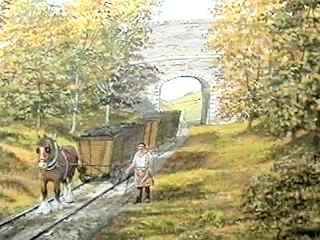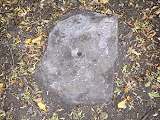|
Dramway
Information (see
also timelines)
This
information is derived in part from an SBL related webpage,
copyright
holder unknown, contact us if it's you!
An Overview
and history:
The local colliery
owners were always unhappy about road transport
and by the 1820s demand for coal in the glass, sugar
and soap industries of Bristol made a better transport
link essential.
The "Avon
and Gloucester Dramroad". / Dramway" was
started in 1828 by the Kennet and Avon Canal Company. It
was the second oldest overground rail system in
the West of England predating Brunel's GWR by 10
years.

Artist's
impression of the Dramway near Siston Common
It was a single-track
railway and the rails were laid 4' 8˝" (143.51cm)
apart. This distance is the railway's "gauge",
and was later known as the "standard gauge"
because it became usual on all British railways.
In 1830 Hole Lane pit in Warmley
and Avon Wharf in Keynsham were linked. By 1831
the line ran to Siston Hill Pit. The first passengers also
used the railway in 1831, all
were company managers they made the journey from
Siston Hill Pit to Keynsham in about 45 mins.
The
line was officially opened in 1832.
| Each of the wagons
on the dramway held four tons of coal and
ran along rails which were fitted to stone “sleepers”
quarried in Wick and North Common.
One
of the few remaining dramway sleepers,
with characteristic round 'bolt' holes,
still in place is shown here.
|

|
The
wagons were pulled by horse up the line (there is
a drop of 198 feet from Mangotsfield to the Avon)
so they were only used on the downward journey
in the passing loops, or where the incline was shallow.
The horse walked between the rails, the driver beside
the wagon operated the brakes. This was known as
a "horse and gravity" railway. The horses were stabled
at Avonside Wharf.
From the wagons the coal
was transferred to barges at the two wharfs or “backs”
– the Londonderry and Avonside. The barges
held 60 boxes, each containing three tons. The cargo
was then shipped down river to Bristol.
Accidents happened
infrequently, though on at least one occasion the
driver failed to apply the brakes and the wagon
over-ran the horse and killed it.
Most of the dramway closed
in 1865, but the last part was not shut down until
much later in1904.
|